Äîêóìåíòàöèÿ è îïèñàíèÿ www.docs.chipfind.ru

August 1999
1
MIC2954
MIC2954
Micrel
MIC2954
250mA Low-Dropout Regulator
Micrel, Inc. · 1849 Fortune Drive · San Jose, CA 95131 · USA · tel + 1 (408) 944-0800 · fax + 1 (408) 944-0970 · http://www.micrel.com
Features
· High-accuracy 5V, guaranteed 250mA output
· Low quiescent current
· Low dropout voltage
· Extremely tight load and line regulation
· Very low temperature coefficient
· Current and thermal limiting
· Input can withstand 20V reverse battery and
+60V positive transients
· Error flag warns of low output voltage
· Logic-controlled electronic shutdown
· Output programmable from 1.24V to 29V
(MIC2954-07/08)
· Available in TO-220, TO-92, and surface-mount
SOT-223 and SOP-8 packages
Applications
· Battery powered equipment
· Cellular telephones
· Laptop, notebook, and palmtop computers
· PCMCIA V
CC
and V
PP
regulation/switching
· Bar code scanners
· Automotive electronics
· SMPS post-regulator/dc-to-dc modules
· Voltage reference
· High-efficiency linear power supplies
General Description
The MIC2954 is a "bulletproof" efficient voltage regulator with
very low dropout voltage (typically 40mV at light loads and
375mV at 250mA), and low quiescent current (120
µ
A typi-
cal). The quiescent current of the MIC2954 increases only
slightly in dropout, thus prolonging battery life. Key MIC2954
features include protection against reversed battery, fold-
back current limiting, and automotive load dump protection
(60V positive transient).
The MIC2954-07/08BM is an adjustable version that includes
an error flag output that warns of a low output voltage, which
is often due to failing batteries on the input. This may also be
used as a power-on reset. A logic-compatible shutdown input
is provided which enables the regulator to be switched on and
off. This part may be pin-strapped for 5V output, or pro-
grammed from 1.24V to 29V with the use of two external
resistors.
The MIC2954 is available in two voltage tolerances,
±
0.5%
maximum and
±
1% maximum. Both are guaranteed for
junction temperatures from 40
°
C to +125
°
C.
The MIC2954 has a very low output voltage temperature
coefficient and extremely good load and line regulation
(0.04% typical).
Typical Applications
MIC2954
IN
OUT
GND
2.2µF
V
IN
V
OUT
5V Fixed Regulator
SHUTDOWN
ENABLE
MIC2954-07/-08
IN
OUT
GND
3.3µF
V
IN
+7V
V
OUT
5V or 3.3V
SHDN
FB
300k
1%
100pF
180k
1%
ERR
Q1 ON = 3.3V
Q1 OFF = 5.0V
1
3
8
5
7
4
220k
1%
Q1
2N2222
5V
3.3V
470k
5V or 3V Selectable Regulator with Shutdown
SHUTDOWN
ENABLE
MIC2954
IN
OUT
GND
10µF
V
IN
V
OUT
1.2V to 30V
SHDN
FB
R1
100pF
R2
ERR
100k
V
ERR
2, 6 = OPEN
1
3
8
5
7
4
V
REF
V
V
1
R1
R2
OUT
REF
=
+
Adjustable Regulator
SHUTDOWN
ENABLE
MIC2954-07/-08
IN
OUT
GND
V
IN
V
OUT
V
IN
*
SHDN
FB
ERR
* MINIMUM INPUT-TO-OUTPUT
VOLTAGE RANGES FROM
40mV TO 400mV DEPENDING
UPON LOAD CURRENT
1
3
8
5
7
4
Wide Input-Voltage-Range Current Limiter
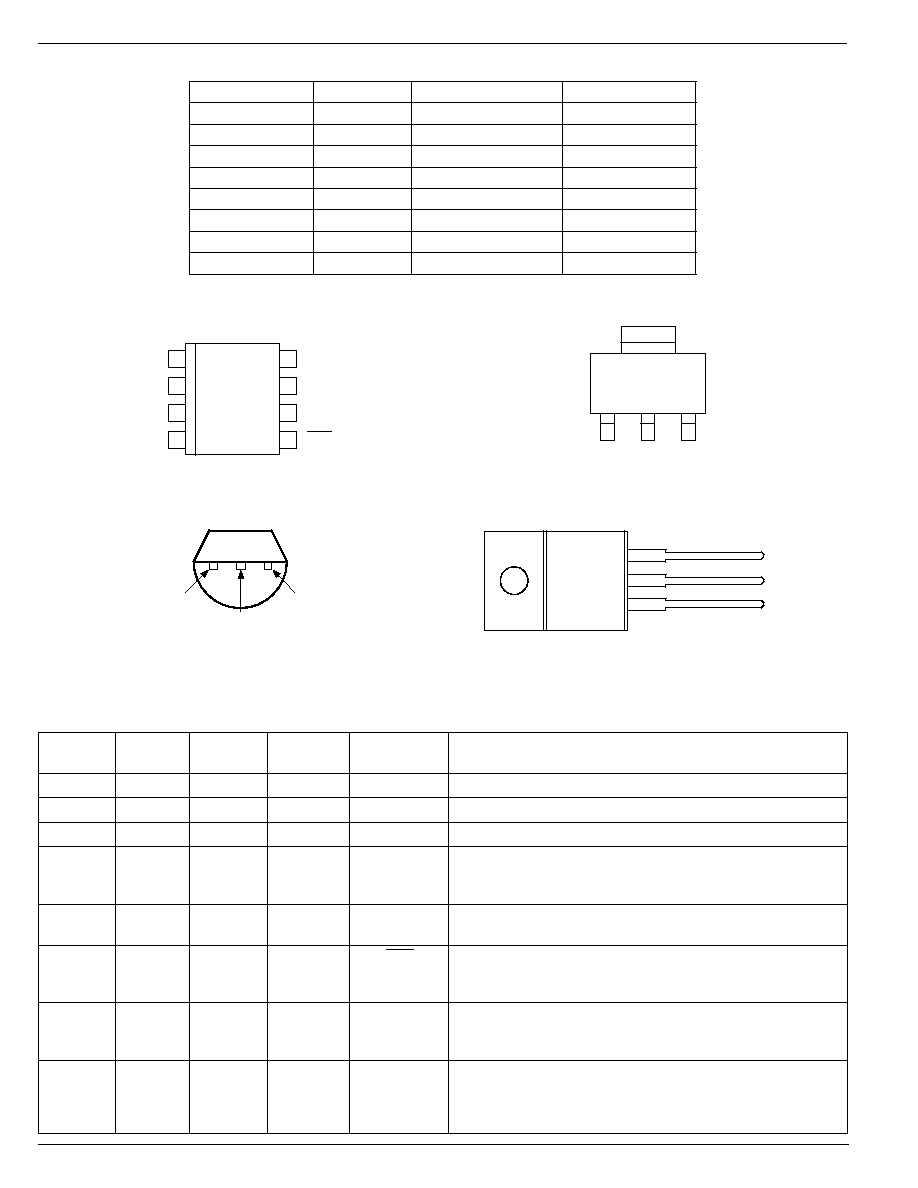
MIC2954
Micrel
MIC2954
2
August 1999
Pin Configuration
1
2
3
4
8
7
6
5
IN
FB
TAP
ERR
OUT
SNS
SHDN
GND
MIC2954
SOP-8 (M)
GND
OUT
IN
3
2
1
TO-92 (Z)
IN
OUT
GND
1
3
2
TAB
GND
SOT-223 (S)
TAB
3
OUT
2
GND
1
IN
TO-220 (T)
Ordering Information
Part Number
Accuracy
Junc. Temp. Range
Package
MIC2954-02BT
0.5%
40
°
C to +125
°
C
TO-220
MIC2954-03BT
1.0%
40
°
C to +125
°
C
TO-220
MIC2954-02BS
0.5%
40
°
C to +125
°
C
SOT-223
MIC2954-03BS
1.0%
40
°
C to +125
°
C
SOT-223
MIC2954-02BZ
0.5%
40
°
C to +125
°
C
TO-92
MIC2954-03BZ
1.0%
40
°
C to +125
°
C
TO-92
MIC2954-07BM
0.5%
40
°
C to +125
°
C
SOP-8
MIC2954-08BM
1.0%
40
°
C to +125
°
C
SOP-8
Pin Description
Pin No.
Pin No.
Pin No.
Pin No.
Pin Name
Pin Function
SOT-223
SOP-8
TO-220
TO-92
1
8
1
1
IN
Supply Input
2,
TAB
4
2
2
GND
Ground
3
1
3
3
OUT
Regulator Output
2
SNS
Sense (Input): Output-sense-voltage end of internal resistive
divider. Connect to OUT (V
OUT
= 5V) for fixed 5V operation;
also see TAP. Not used in adjustable configuration.
3
SHDN
Shutdown (Input): Active-low input enables regulator.
(Low = enable; high = shutdown.)
5
ERR
Error Flag (Output): Open collector (active-low) output. Active
state indicates an output (V
OUT
) undervoltage condition.
(Low = error, floating = normal.)
6
TAP
Divider Tap (Output): Resistive voltage divider tap. With 5V
applied to SNS, V
TAP
is approximately 1.23V. Connect to
FB for 5V operation. Not used in adjustable configuration.
7
FB
Feedback (Input): Error amplifier input. Compared to internal
1.23V reference. Connect to external voltage divider for
adjustable operation or internal voltage divider (TAP) for 5V
operation (see SNS, TAP).

August 1999
3
MIC2954
MIC2954
Micrel
Absolute Maximum Ratings
(Note 1)
Input Voltage (V
IN
) ........................................ 20V to +60V
Feedback Voltage (V
FB
), Note 14,15 ........... 1.5V to +26V
Shutdown Input Voltage (V
SHDN
) ................. 0.3V to +30V
Error Output Voltage (V
ERR
) ........................ 0.3V to +30V
Power Dissipation (P
D
), Note 4 ............... Internally Limited
Storage Temperature (T
S
) ....................... 65
°
C to +150
°
C
Lead Temperature (soldering, 5 sec.) ....................... 260
°
C
ESD, Note 3
Operating Ratings
(Note 2)
Input Voltage (V
IN
) ....................................... +2.0V to +30V
Junction Temperature (T
J
) ....................... 40
°
C to +125
°
C
Package Thermal Temperature (
JC,
JA
) ................ Note 5
Electrical Characteristics
MIC2954-07/08: V
FB
= V
TAP
; V
SNS
= V
OUT
; V
SHDN
0.6V. All versions: V
IN
= 6V; I
L
= 1mA; C
L
= 2.2
µ
F; T
J
= 25
°
C,
bold values indicate 40
°
C
T
J
+125
°
C; Note 8; unless noted.
Symbol
Parameter
Conditions
Min
Typ
Max
Units
V
OUT
Output Voltage
MIC2954-02/-07 (
±
0.5%)
4.975
5.000
5.025
V
4.940
5.060
V
MIC2954-02/-07 (
±
0.5%), 1mA
I
L
250mA
4.930
5.000
5.070
V
MIC2954-03/-08 (
±
1%)
4.950
5.000
5.050
V
4.900
5.100
V
MIC2954-03/-08 (
±
1%), 1mA
I
L
250mA
4.880
5.000
5.120
V
V
OUT
/
T
Output Voltage
MIC2954-02/-07 (
±
0.5%)
20
100
ppm/
°
C
Temperature Coefficient, Note 6
MIC2954-03/-08 (
±
1%)
20
150
ppm/
°
C
V
OUT
/V
OUT
Line Regulation, Note 7
MIC2954-02/-07 (
±
0.5%), V
IN
= 6V to 26V
0.03
0.10
%/V
0.20
%/V
MIC2954-03/-08 (
±
1%), V
IN
= 6V to 26V
0.03
0.20
%/V
0.40
%/V
V
OUT
/V
OUT
Load Regulation, Note 8
MIC2954-02/-07 (
±
0.5%), I
L
= 1 to 250mA,
0.04
0.16
%/V
0.20
%/V
MIC2954-03/-08 (
±
1%), I
L
= 1 to 250mA,
0.04
0.20
%/V
0.30
%/V
V
IN
V
OUT
Dropout Voltage, Note 9
I
L
= 1mA
60
100
mV
150
mV
I
L
= 50mA
220
250
mV
420
mV
I
L
= 100mA
250
300
mV
450
mV
I
L
= 250mA
375
450
mV
600
mV
I
GND
Ground Pin Current, Note 10
I
L
= 1mA
140
200
µ
A
300
µ
A
I
L
= 50mA
0.5
1
mA
2
mA
I
L
= 100mA
1.7
2.5
mA
3.5
mA
I
L
= 250mA
5
9
mA
12
mA
I
GND(DO)
Ground Pin Current at Dropout,
V
IN
= 4.5V
180
300
µ
A
Note 10
I
LIMIT
Current Limit, Note 11
V
OUT
= 0V
750
mA
800
mA

MIC2954
Micrel
MIC2954
4
August 1999
Symbol
Parameter
Conditions
Min
Typ
Max
Units
V
OUT
/
P
D
Thermal Regulation, Note 12
0.05
0.2
%/W
e
n
Output Noise Voltage
I
L
= 100mA, C
L
= 2.2
µ
F
400
µ
V(rms)
(10Hz to 100kHz)
I
L
= 100mA, C
L
= 33
µ
F
260
µ
V(rms)
Reference Voltage
MIC2954-02/-07 (
±
0.5%)
1.220
1.235
1.250
V
1.200
1.260
V
MIC2954-03/-08 (
±
1%)
1.210
1.235
1.260
V
1.200
1.270
V
Reference Voltage
MIC2954-02/-07 (
±
0.5%), Note 13
1.190
1.270
V
MIC2954-03/-08 (
±
1%), Note 13
1.185
1.285
V
Feedback Pin Bias Current
20
40
nA
60
nA
Reference Voltage
MIC2954-02/-07 (
±
0.5%)
20
ppm/
°
C
Temperature Coefficient, Note 12
MIC2954-03/-08 (
±
1%)
50
ppm/
°
C
Feedback Pin Bias Current
0.1
40
nA/
°
C
Temperature Coefficient
Error Comparator
Output Leakage Current
V
OH
= 30V
0.01
1.00
µ
A
2.00
µ
A
Output Low Voltage
V
IN
= 4.5V, I
OL
= 400
µ
A
150
250
mV
400
mV
Upper Threshold Voltage
Note 14
60
40
mV
25
mV
Lower Threshold Voltage
Note 14
75
95
mV
140
mV
Hysteresis
Note 14
15
mV
Shutdown Input
Input Logic Voltage
low (on)
1.3
0.7
V
high (off)
2.0
V
Shutdown Pin Input Current
V
SHDN
= 2.4V
30
50
µ
A
100
µ
A
V
SHDN
= 30V
450
600
µ
A
750
µ
A
Regular Output Current in
Note 15
3
10
µ
A
Shutdown
20
µ
A
Note 1.
Exceeding the absolute maximum rating may damage the device.
Note 2.
The device is not guaranteed to function outside its operating rating.
Note 3.
Devices are ESD sensitive. Handling precautions recommended.
Note 4.
P
D(max)
= (T
J(max)
T
A
)
÷
JC
. Exceeding T
J(max)
will cause thermal shutdown.
Note 5.
Thermal resistance (
JC
) of the TO-220 package is 2.5
°
C/W, and 15
°
C/W for the SOT-223. Thermal resistance (
JC
) of the TO-92 package is
180
°
C/W with 0.4" leads and 160
°
C/W with 0.25" leads. Thermal resistance (
JA
) of the SOP-8 is 160
°
C/W mounted on a printed circuit board
(See "Application Information: Thermal Calculation").
Note 6.
Output voltage temperature coefficient is defined as the worst case voltage change divide by the total temperature range.
Note 7.
Line regulation for the MIC2954 is tested at 125
°
C for I
L
= 1mA. For I
L
= 100
µ
A and T
J
= 125
°
C, line regulation is guaranteed by design to
0.2%. See "Typical Characteristics" for line regulation versus temperature and load current.
Note 8.
Regulation is measured at constant junction temperature using low duty cycle pulse testing. Changes in output voltage due to heating effects
are covered by the thermal regulation specification.
Note 9.
Dropout Voltage is defined as the input to output differential at which the output voltage drops 100 mV below its nominal value measured at 1V
differential. At very low values of programmed output voltage, the minimum input supply voltage of 2 V (2.3V over temperature) must be taken
into account.
Note 10. Ground pin current is the regulator quiescent current. The total current drawn from the source is the sum of the load current plus the ground
pin current.

August 1999
5
MIC2954
MIC2954
Micrel
Note 11. The MIC2954 features fold-back current limiting. The short circuit (V
OUT
= 0V) current limit is less than the maximum current with normal
output voltage.
Note 12. Thermal regulation is defined as the change in output voltage at a time t after a change in power dissipation is applied, excluding load or line
regulation effects. Specifications are for a 200mA load pulse at V
IN
= 20V (a 4W pulse) for t = 10ms.
Note 13. V
REF
V
OUT
(V
IN
1V), 2.3V
V
IN
30V, 100
µ
A < I
L
250 mA, T
J
T
J(max).
Note 14. Comparator thresholds are expressed in terms of a voltage differential at the FB pin below the nominal reference voltage measured at 6V
input. To express these thresholds in terms of output voltage change, multiply by the error amplifier gain = V
OUT
/V
REF
= (R1 + R2)/R2. For
example, at a programmed output voltage of 5V, the error output is guaranteed to go low when the output drops by
95mV
×
5V/1.235V = 384mV. Thresholds remain constant as a percent of V
OUT
as V
OUT
is varied, with the dropout warning occurring at
typically 5% below nominal, 7.5% guaranteed.
Note 15. V
SHDN
2V, V
IN
30 V,V
OUT
= 0, with the FB pin connected to TAP.
Note 16. When used in dual supply systems where the regulator load is returned to a negative supply, the output voltage must be diode clamped to
ground.
Note 17. Maximum positive supply voltage of 60V must be of limited duration (<10ms) and duty cycle (<1%). The maximum continuous supply voltage
is 30V.
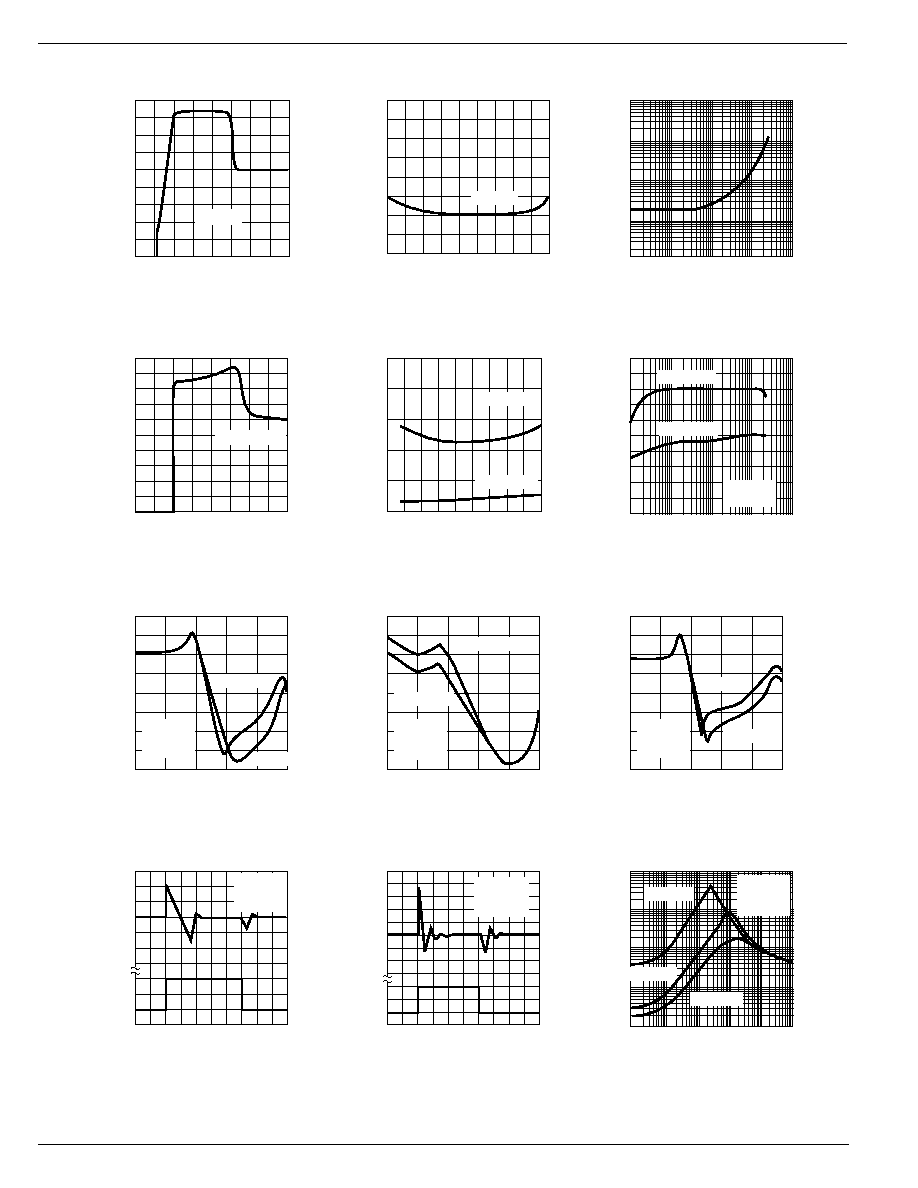
MIC2954
Micrel
MIC2954
6
August 1999
Typical Characteristics
Output Noise Voltage
0.1
1
10
100
300
200
100
0
LOAD CURRENT (mA)
NOISE VOLTAGE (µVrms)
1000
500
CL = 2.2 µF
400
CL = 33 µF
VIN =6V
VOUT =5V
Ground Pin Current
15
10
5
0
-75 -50 -25 0 25 50 75 100125 150
JUNCTION TEMPERATURE (
°
C)
GROUND PIN CURRENT (mA)
20
25
I L = 250mA
I L = 100 mA
Ground Pin Current
16
14
12
10
8
6
2
0
0
1
2
3
4
5
6
7
8
I L = 250 mA
INPUT VOLTAGE (V)
GROUND PIN CURRENT (mA)
18
20
Ground Pin Current
400
300
200
100
0
-75 -50 -25 0 25 50 75 100 125 150
I L = 1mA
TEMPERATURE (
°
C)
GROUND PIN CURRENT (µA)
Ground Pin Current
0
20
40
60
80
100
140
180
0
1
2
3
4
5
6
7
8
I L = 1mA
INPUT VOLTAGE (V)
GROUND PIN CURRENT (µA)
Ground Pin Current vs Load
0.1
1
10
100
10
1
0.1
0.01
OUTPUT CURRENT (mA)
GROUND PIN CURRENT (mA)
1000
100
Ripple Rejection
80
70
60
50
40
30
20
0.01
0.1
1
10
100
1000
I L =1 mA
FREQUENCY (kHz)
RIPPLE REJECTION (dB)
90
100
I L =10mA
VIN =6V
VOUT =5V
CL=2.2µF
Ripple Rejection
70
RIPPLE REJECTION (dB)
60
50
40
30
20
10
0.01
0.1
1
10
100
1000
I L = 100 mA
FREQUENCY (kHz)
80
90
I L = 250mA
VIN =6V
VOUT =5V
CL=10µF
Ripple Rejection
80
RIPPLE REJECTION (dB)
70
60
50
40
30
20
0.01
0.1
1
10
100
1000
I L = 0
FREQUENCY (kHz)
90
100
I L = 100 µA
VIN =6V
VOUT =5V
CL=2.2µF
Line Transient Response
0
-400
8V
6V
0
0.2
0.4
0.6
0.8
1
TIME (mS)
400
CL=2.2µF
I L=10mA
VOUT =5V
OUTPUT VOLTAGE
CHANGE (mV)
INPUT
VOLTAGE
Line Transient Response
0
-40
8V
6V
0
1
2
3
4
5
TIME (mS)
40
CL=33µF
I L=10mA
VOUT =5V
OUTPUT VOLTAGE
CHANGE (mV)
INPUT
VOLTAGE
80
Output Impedance
0.01
OUTPUT IMPEDANCE (
)
0.1
1
10
1
0.1
0.01
FREQUENCY (kHz)
1000
100
10
I L=100µA
I L=10µA
I L=250mA
VIN =6V
VOUT =5V
CL=10µF
100
120
160
4
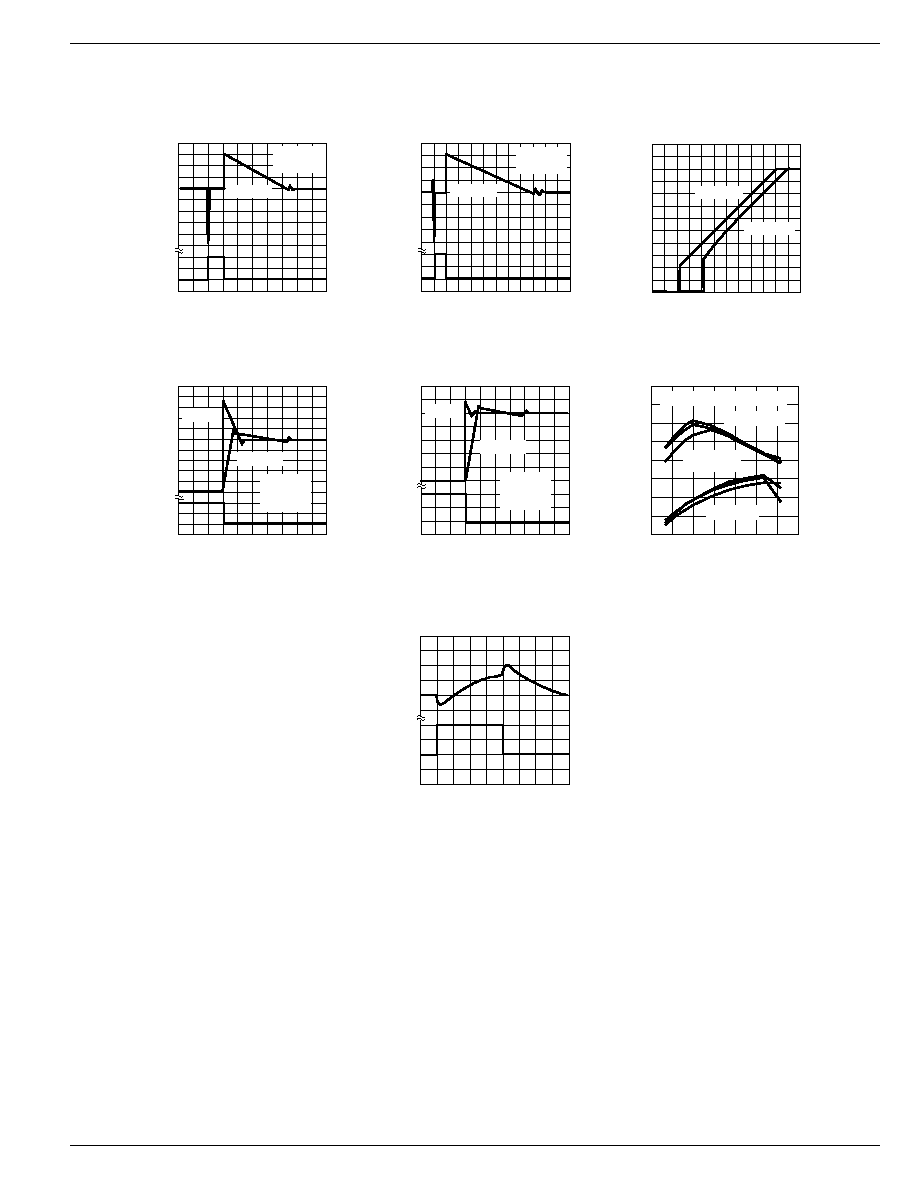
August 1999
7
MIC2954
MIC2954
Micrel
TIME (mS)
Enable Transient
10
8
4
6
4
2
2
0
3
2
1
0
I L=10mA
VIN =14V
VOUT =5V
OUTPUT
VOLTAGE (mV)
SHUTDOWN
VOLTAGE (V)
CL=33µF
0
5
CL=2.2µF
TIME (mS)
Load Transient Response
800
400
40
0
-400
-800
250mA
100µA
30
20
10
0
VIN =6V
VOUT =5V
OUTPUT VOLTAGE
CHANGE (mV)
LOAD
CURRENT
CL=2.2µF
Dropout Characteristics
0
1
2
3
4
5
6
INPUT VOLTAGE (VOLTS)
6
5
4
3
2
1
0
I L=100µA
I L=250mA
OUTPUT VOLTAGE (V)
Load Transient Response
10
20
30
40
50
60
TIME (mS)
200
100
0
-100
-200
250mA
100µA
0
OUTPUT VOLTAGE
CHANGE (mV)
LOAD
CURRENT
VIN =6V
VOUT =5V
CL=33µF
TIME (mS)
Enable Transient
6
4
4
2
0
0
3
2
1
0
I L=10mA
VIN =6V
VOUT =5V
CL=33µF
CL=2.2µF
2
OUTPUT
VOLTAGE (V)
SHUTDOWN
VOLTAGE (V)
5
TIME (mS)
Thermal Regulation
10
40
5
-5
4
0
30
20
10
0
2
OUTPUT VOLTAGE
CHANGE (V)
0
15
POWER
DISSIPATION (W)
300
350
400
450
500
550
600
650
700
-60 -30
0
30
60
90 120 150
CURRENT (mA)
TEMPERATURE (
°
C)
Short Circuit and Maximum
Current vs. Temperature
VOUT = VNOMINAL 0.5V
VOUT = 0V
3 SAMPLES
(HI/AVG/LO)
VOUT = 3.3V
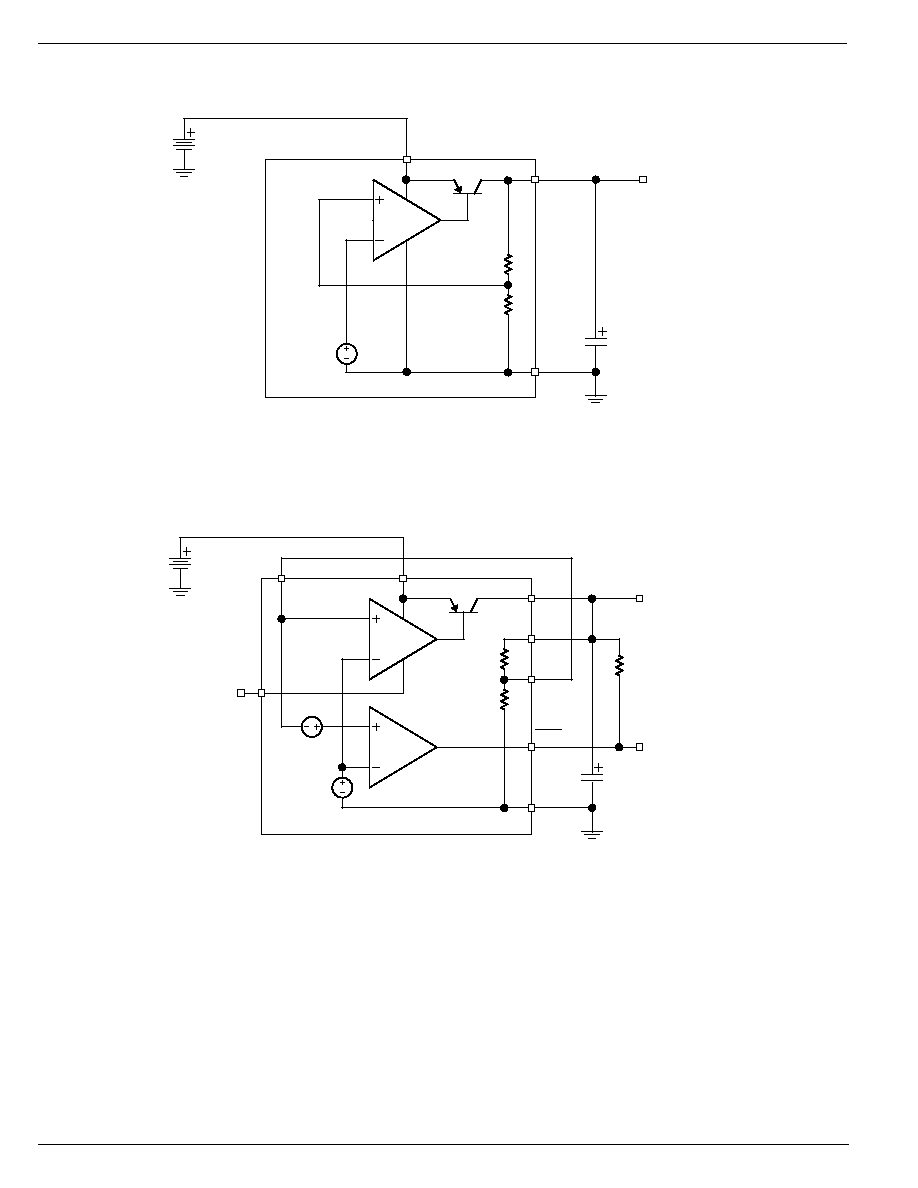
MIC2954
Micrel
MIC2954
8
August 1999
Block Diagrams
1.23V
REF.
Error
Amp.
182k
62k
GND
IN
Unregulated
DC Supply
MIC2954-02/-03
2.2µF
OUT
5V/250mA
Output
MIC2954-02 and MIC2954-03
60mV
1.23V
REF.
Error
Amp.
Error Detection
Comparator
182k
60k
SNS
TAP
ERR
GND
OUT
5V/250mA
Output
TTL/CMOS
Compatible
Error Output
IN
FB
Unregulated
DC Supply
TTL/CMOS
Control Logic
Input
SHDN
330k
MIC2954-07/-08
MIC2954-07 and MIC2954-08

August 1999
9
MIC2954
MIC2954
Micrel
Applications Information
External Capacitors
A 2.2
µ
F (or greater) capacitor is required between the MIC2954
output and ground to prevent oscillations due to instability.
Most types of tantalum or aluminum electrolytics will be
adequate; film types will work, but are costly and therefore not
recommended. Many aluminum electrolytics have electro-
lytes that freeze at about 30
°
C, so solid tantalums are
recommended for operation below 25
°
C. The important
parameters of the capacitor are an effective series resistance
of about 5
or less and a resonant frequency above 500kHz.
The value of this capacitor may be increased without limit.
At lower values of output current, less output capacitance is
required for output stability. The capacitor can be reduced to
0.5
µ
F for current below 10mA or 0.15
µ
F for currents below
1mA. Adjusting the MIC2954-07/-08 to voltages below 5V
runs the error amplifier at lower gains so that more output
capacitance is needed. For the worst-case situation of a
250mA load at 1.23V output (output shorted to feedback) a
5
µ
F (or greater) capacitor should be used.
The MIC2954 will remain in regulation with a minimum load
of 1mA. When setting the output voltage of the MIC2954-07/
-08 version with external resistors, the current through these
resistors may be included as a portion of the minimum load.
A 0.1
µ
F capacitor should be placed from the MIC2954 input
to ground if there is more than 10 inches of wire between the
input and the ac filter capacitor or if a battery is used as the
input.
Error Detection Comparator Output
(MIC2954-07/-08)
A logic-low output will be produced by the comparator when-
ever the MIC2954-07/-08 output falls out of regulation by
more than approximately 5%. This figure is the comparator's
built-in offset of about 60mV divided by the 1.235V reference
voltage. (Refer to the block diagram on page 1). This trip level
remains "5% below normal" regardless of the programmed
output voltage of the MIC2954-07/-08. For example, the error
flag trip level is typically 4.75V for a 5V output or 11.4V for a
12V output. The out of regulation condition may be due either
to low input voltage, current limiting, or thermal limiting.
Figure 1 is a timing diagram depicting the ERR signal and the
regulated output voltage as the MIC2954-07/-08 input is
ramped up and down. The ERR signal becomes valid (low) at
about 1.3V input. It goes high at about 5V input (the input
voltage at which V
OUT
= 4.75). Since the MIC2954-07/-08's
dropout voltage is load-dependent (see curve in "Typical
Characteristics"), the input voltage trip point (about 5V) will
vary with the load current. The output voltage trip point
(approximately 4.75V) does not vary with load.
The error comparator has an open-collector output which
requires an external pull-up resistor. Depending on system
requirements, this resistor may be returned to the 5V output
or some other supply voltage. In determining a value for this
resistor, note that while the output is rated to sink 400
µ
A, this
sink current adds to battery drain in a low battery condition.
Suggested values range from 100k to 1M
. The resistor is
not required if this output is unused.
Programming the Output Voltage
(MIC2954-07/-08)
The MIC2954-07/-08 may be pin-strapped for 5V using its
internal voltage divider by tying pin 1 (OUT) to pin 2 (SNS) and
pin 7 (FB) to pin 6 (TAP). Alternatively, it may be programmed
for any output voltage between its 1.235V reference and its
30V maximum rating. An external pair of resistors is required,
as shown in Figure 3.
The complete equation for the output voltage is
V
= V
R1
R2
I
R
OUT
REF
FB
1
1
+
+
where:
V
REF
= nominal 1.235V reference voltage
I
FB
= nominal FB pin bias current (20nA)
The minimum recommended load current of 1
µ
A forces an
upper limit of 1.2M
on the value of R2, if the regulator must
work with no load (a condition often found in CMOS in
standby), I
FB
will produce a 2% typical error in V
OUT
which
may be eliminated at room temperature by trimming R1. For
better accuracy, choosing R2 = 100k reduces this error to
0.17% while increasing the resistor program current to 12
µ
A.
Since the MIC2954-07/-08 typically draws 60
µ
A at no load
with pin 2 (SNS) open-circuited, this is a negligible addition.
Reducing Output Noise
In reference applications it may be advantageous to reduce
the ac noise present at the output. One method is to reduce
the regulator bandwidth by increasing the size of the output
capacitor. This is relatively inefficient, as increasing the
capacitor from 1
µ
F to 220
µ
F only decreases the noise from
430
µ
V to 160
µ
V
RMS
for a 100kHz bandwidth at 5V output.
Noise can be reduced fourfold by a bypass capacitor across
R1, since it reduces the high frequency gain from 4 to unity.
Pick:
C
2 R1 200Hz
BYPASS
×
1
*See Application Information
Figure 1. Error Output Timing
Output
Voltage
Input
Voltage
ERR
Not
Valid
Not
Valid
5V
1.3V
4.75V
*
*

MIC2954
Micrel
MIC2954
10
August 1999
or about 0.01
µ
F. When doing this, the output capacitor must
be increased to 3.3
µ
F to maintain stability. These changes
reduce the output noise from 430
µ
V to 100
µ
V rms for a
100kHz bandwidth at 5V output. With the bypass capacitor
added, noise no longer scales with output voltage so that
improvements are more dramatic at higher output voltages.
Automotive Applications
The MIC2954 is ideally suited for automotive applications for
a variety of reasons. It will operate over a wide range of input
voltages with very low dropout voltages (40mV at light loads),
and very low quiescent currents (75
µ
A typical). These
features are necessary for use in battery powered systems,
such as automobiles. It is a "bulletproof" device with the ability
to survive both reverse battery (negative transients up to 20V
below ground), and load dump (positive transients up to 60V)
conditions. A wide operating temperature range with low
temperature coefficients is yet another reason to use these
versatile regulators in automotive designs.
Thermal Calculations
Layout Considerations
The MIC2954-07BM/-08BM (8-pin surface-mount package)
has the following thermal characteristics when mounted on a
single layer copper-clad printed circuit board.
PC Board Dielectric Material
JA
FR4
160
°
C/W
Ceramic
120
°
C/W
Multilayer boards having a ground plane, wide traces near the
pads, and large supply bus lines provide better thermal
conductivity.
Our calculations will use the "worst case" value of 160
°
C/W,
which assumes no ground plane, minimum trace widths, and
a FR4 material board.
Pad Layout (minimum recommended geometry)
Nominal Power Dissipation and Die Temperature
The MIC2954-07BM/-08BM at a 55
°
C ambient temperature
will operate reliably at up to 440mW power dissipation when
mounted in the "worst case" manner described above. This
power level is equivalent to a die temperature of 125
°
C, the
recommended maximum temperature for nonmilitary grade
silicon integrated circuits.
245 mil
30 mil
50 mil
50 mil
150 mil
FEEDBACK
SENSE
Q15A
OUT
Q24
Q26
R27
182 k
5V TAP
R28
60 k
R18
20k
Q25
Q23
Q22
R15
100 k
R16
30 k
Q29
Q28
R17
10
R21 8
R17
12 k
Q31
Q30
R23 60 k
SHDN
R24
50 k
R22
150 k
Q21
Q19
C2
40 pF
R14
350
k
Q14
R13
100
k
Q18
R12
110
k
Q20
Q9
Q15B
Q8
Q7
R11
20.6
k
Q5
R8
31.4 k
R10
150
k
R9
27.8 k
Q11
Q12
Q13
R6
140
k
R5
180
k
R4
13 k
R3
50 k
Q2
C1
20
pF
Q4
Q3
R11
18
k
Q6
Q1
10
R1
20 k
R2
50 k
Q41
R30
30
k
Q40
Q34
GND
Q36
Q37
R25
2.8 k
Q38
ERROR
R26
60 k
Q39
DENOTES CONNECTION ON
MIC2954-02Bx/-03Bx ONLY
Q42
Q16
Q17
50 k
10 k
IN
Schematic Diagram
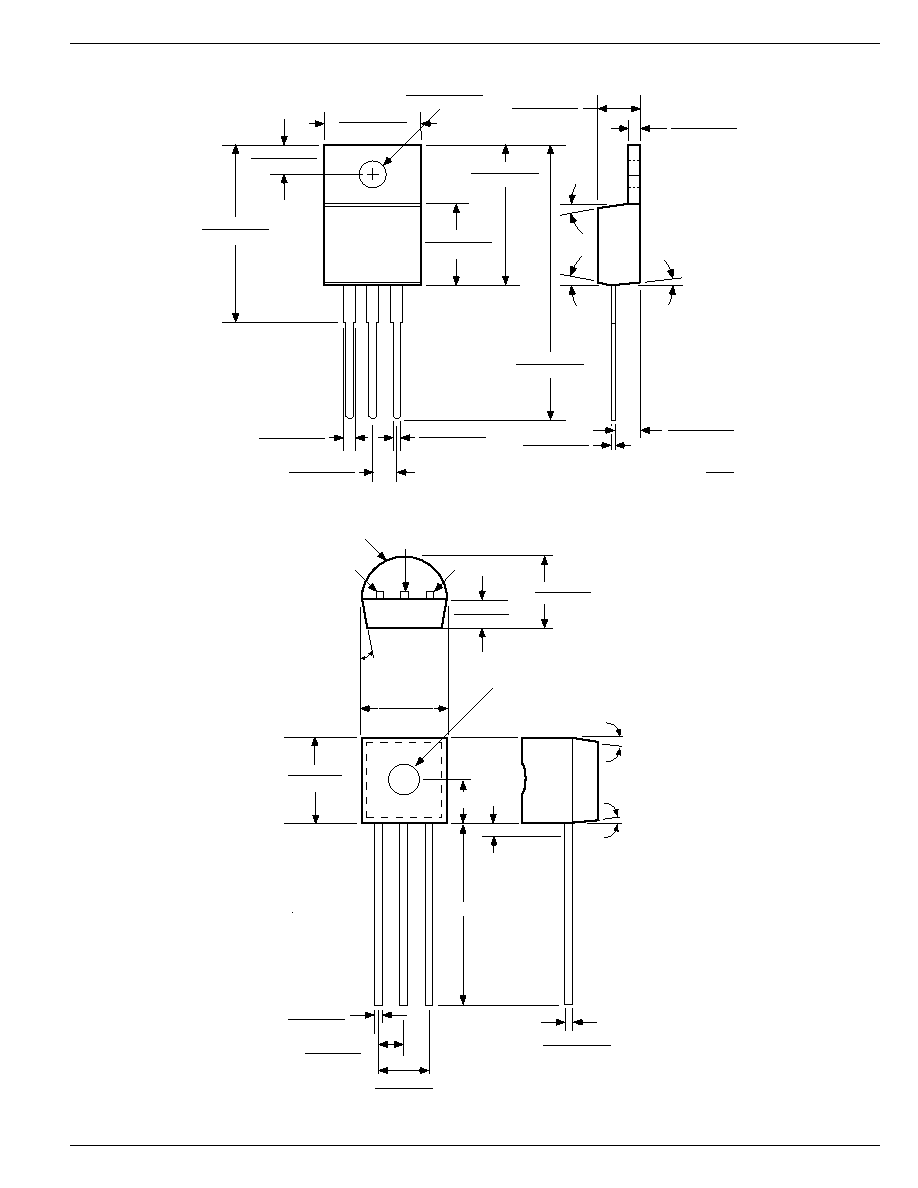
August 1999
11
MIC2954
MIC2954
Micrel
Package Information
0.018
±
0.008
(0.46
±
0.020)
0.100
±
0.005
(2.54
±
0.13)
0.030
±
0.003
(0.76
±
0.08)
0.050
±
0.003
(1.27
±
.08)
7
°
1.140
±
0.010
(28.96
±
0.25)
0.356
±
0.005
(9.04
±
0.13)
0.590
±
0.005
(14.99
±
0.13)
0.108
±
0.005
(2.74
±
0.13)
0.050
±
0.005
(1.27
±
0.13)
0.151 D
±
0.005
(3.84 D
±
0.13)
0.410
±
0.010
(10.41
±
0.25)
0.176
±
0.005
(4.47
±
0.13)
0.100
±
0.020
(2.54
±
0.51)
0.818
±
0.005
(20.78
±
0.13)
7
°
3
°
DIMENSIONS: INCH
(MM)
TO-220 (T)
3
2
1
10
°
typ.
5
°
typ.
5
°
typ.
0.185 (4.699)
0.175 (4.445)
0.185 (4.699)
0.175 (4.445)
0.085 (2.159) Diam.
0.500 (12.70) Min.
0.090 (2.286) typ.
0.0155 (0.3937)
0.0145 (0.3683)
Seating Plane
0.025 (0.635) Max
Uncontrolled
Lead Diameter
0.016 (0.406)
0.014 (0.356)
0.105 (2.667)
0.095 (2.413)
0.055 (1.397)
0.045 (1.143)
0.090 (2.286) Radius, typ.
0.145 (3.683)
0.135 (3.429)
0.055 (1.397)
0.045 (1.143)
BOTTOM VIEW
TO-92 (Z)

MIC2954
Micrel
MIC2954
12
August 1999
MICREL INC.
1849 FORTUNE DRIVE
SAN JOSE, CA 95131
USA
TEL
+ 1 (408) 944-0800
FAX
+ 1 (408) 944-0970
WEB
http://www.micrel.com
This information is believed to be accurate and reliable, however no responsibility is assumed by Micrel for its use nor for any infringement of patents or
other rights of third parties resulting from its use. No license is granted by implication or otherwise under any patent or patent right of Micrel Inc.
© 1999 Micrel Incorporated
45
°
0
°
8
°
0.244 (6.20)
0.228 (5.79)
0.197 (5.0)
0.189 (4.8)
SEATING
PLANE
0.026 (0.65)
MAX
)
0.010 (0.25)
0.007 (0.18)
0.064 (1.63)
0.045 (1.14)
0.0098 (0.249)
0.0040 (0.102)
0.020 (0.51)
0.013 (0.33)
0.157 (3.99)
0.150 (3.81)
0.050 (1.27)
TYP
PIN 1
DIMENSIONS:
INCHES (MM)
0.050 (1.27)
0.016 (0.40)
SOP-8 (M)
16
°
10
°
0.84 (0.033)
0.64 (0.025)
1.04 (0.041)
0.85 (0.033)
2.41 (0.095)
2.21 (0.087)
4.7 (0.185)
4.5 (0.177)
6.70 (0.264)
6.30 (0.248)
7.49 (0.295)
6.71 (0.264)
3.71 (0.146)
3.30 (0.130)
3.15 (0.124)
2.90 (0.114)
10
°
MAX
0.10 (0.004)
0.02 (0.0008)
0.038 (0.015)
0.25 (0.010)
C
L
DIMENSIONS:
MM (INCH)
C
L
1.70 (0.067)
1.52 (0.060)
0.91 (0.036) MIN
SOT-223 (S)











